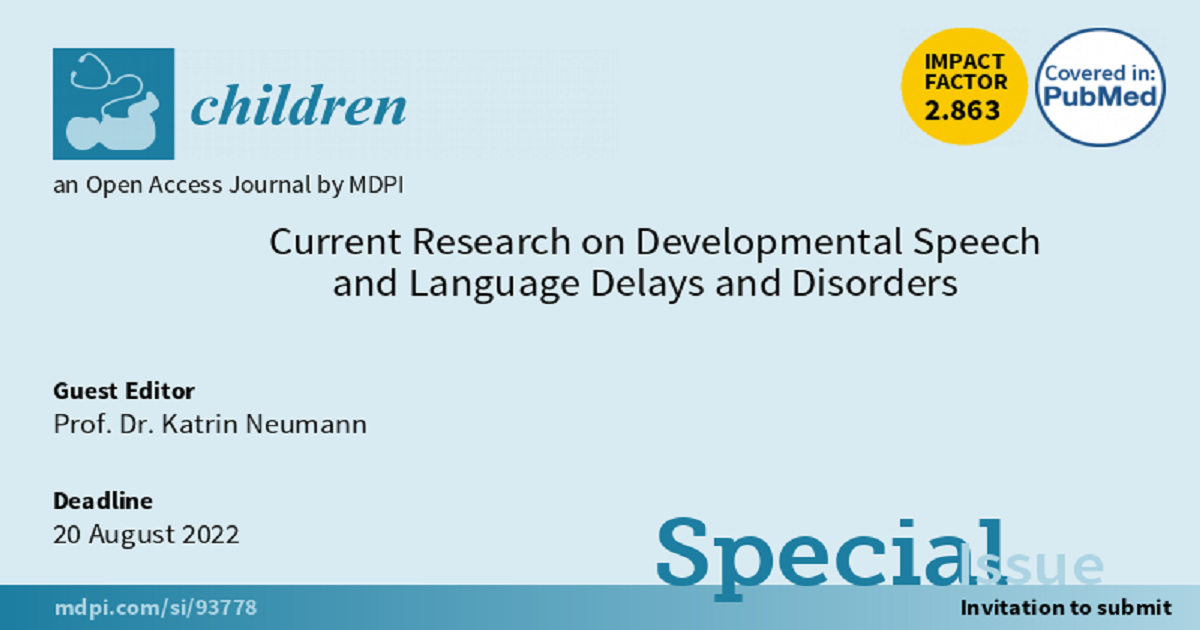Current Research on Developmental Speech and Language Delays and Disorders
A special issue of Children (ISSN 2227-9067). This special issue belongs to the section "Child Neurology".
Deadline for manuscript submissions: closed (20 August 2022) | Viewed by 25458

Special Issue Editor
Interests: examination of speech; language, and hearing processes with behavioral and neuroimaging techniques; implementation of newborn hearing screening; hearing screenings for people with intellectual disabilities; language screenings for children, and of neonatal CMV screenings; population medicine in communication disorders; nature and treatment of stuttering; signal analysis in voice physiology and pathology; singer´s voice; diagnostics; treatment and rehabilitation of children with language disorders and of people with hearing loss, the latter focussing on hearing aids and implants; coordination of the German evidence-based guidelines on the treatement of developmental language disorders and delay and on the pathogenesis, assessment, and treatment of speech fluency disorders
Special Issue Information
Dear Colleagues,
Developmental language disorders are among the most frequently treated disorders of childhood. Neither their categorization into subtypes and their definitions and nomenclatures nor their differentiation from related disorders are trivial, especially in the case of low nonverbal IQ. They may affect one or more of the morphological-syntactic, semantic-lexical, and phonological domains of the language system. Speech sound disorders including Childhood Apraxia of Speech are only partially among them. Receptive developmental language disorders have poorer prognoses than expressive ones, with pure forms of both classes existing less frequently than previously thought. While short-term treatment success for developmental language disorders has been documented, evidence for long-term benefit is meager. Studies tend to be characterized by small sample sizes and poorly comparable manuals. They also vary in settings, frequency, age ranges, and duration. Another disorder that interferes with children's oral communication is motor speech disorders.
This special issue addresses the nature, definition, assessment, and evidence-based treatments of developmental language disorders, speech sound disorders, and motor speech disorders in children, including treatment settings and medium- and long-term therapy effects. Effective interventions also need to be extracted from the current body of studies for developmental language delays, which precede developmental language disorders, balancing parent-centered intervention methods against therapies delivered by speech-language therapists. In addition, the Special Issue aims to contribute to the current nomenclature discussion of speech and language disorders in children.
Prof. Dr. Katrin Neumann
Guest Editor
Manuscript Submission Information
Manuscripts should be submitted online at www.mdpi.com by registering and logging in to this website. Once you are registered, click here to go to the submission form. Manuscripts can be submitted until the deadline. All submissions that pass pre-check are peer-reviewed. Accepted papers will be published continuously in the journal (as soon as accepted) and will be listed together on the special issue website. Research articles, review articles as well as short communications are invited. For planned papers, a title and short abstract (about 100 words) can be sent to the Editorial Office for announcement on this website.
Submitted manuscripts should not have been published previously, nor be under consideration for publication elsewhere (except conference proceedings papers). All manuscripts are thoroughly refereed through a single-blind peer-review process. A guide for authors and other relevant information for submission of manuscripts is available on the Instructions for Authors page. Children is an international peer-reviewed open access monthly journal published by MDPI.
Please visit the Instructions for Authors page before submitting a manuscript. The Article Processing Charge (APC) for publication in this open access journal is 2400 CHF (Swiss Francs). Submitted papers should be well formatted and use good English. Authors may use MDPI's English editing service prior to publication or during author revisions.
Keywords
- children
- language delay
- developmental language disorder
- language impairment
- speech sound disorder
- treatment
- therapy
- intervention
- parent
- evidence






